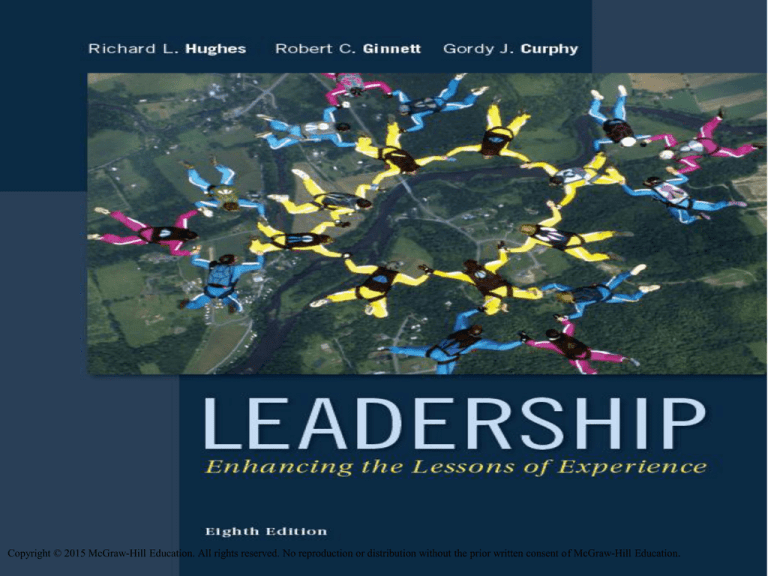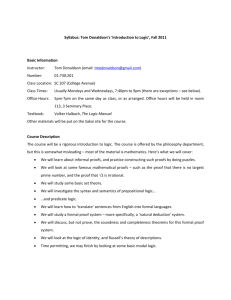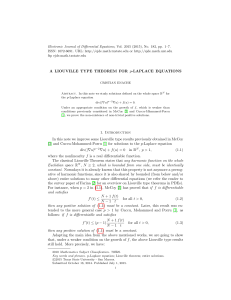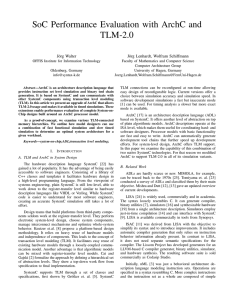
Copyright © 2015 McGraw-Hill Education. All rights reserved. No reproduction or distribution without the prior written consent of McGraw-Hill Education.
8-1
Chapter
10
Groups, Teams, and
Their Leadership
“We are born for cooperation, as are
the feet, the hands, the eyelids, and the
upper and lower jaws.”
~Marcus Aurelius
8-2
Introduction
• Groups and teams are different than solely the
skills, abilities, values, and motives of those
who comprise them.
• Groups and teams have their own special
characteristics.
• Groups are essential if leaders are to impact
anything beyond their own behavior.
• Group perspective looks at how different
group characteristics can affect relationships
both with the leader and among the followers.
8-3
Individuals Versus
Groups Versus Teams
• Team members usually have a stronger sense
of identification among themselves, than group
members do.
• Teams have common goals or tasks.
• Task independence typically is greater with
teams than with groups.
• Team members often have more differentiated
and specialized roles than group members.
• Teams should be considered highly specialized
groups.
8-4
The Nature of Groups
• A group is two or more persons interacting with
one another in a manner that each person
influences and is influenced by each other
person.
– This definition incorporates the concept of reciprocal
influence between leaders and followers.
– Group members interact and influence each other.
– The definition does not constrain individuals to only
one group
• Although groups play a pervasive role in
society, most people spend little time thinking
about the factors that affect group processes
and intragroup relationships.
8-5
Group Size
• Leader emergence is partly a function of group
size.
• As groups become larger, cliques are more
likely to develop.
• Group size can affect a leader’s behavioral
style.
– Leaders with a large span of control tend to be more
directive, spend less time with individual subordinates,
and use impersonal methods to influence followers.
– Leaders with a small span of control tend to show
more consideration and use personal approaches to
influence followers.
• Group size affects group effectiveness.
8-6
Group Size (continued)
• Additive task: A task where the group’s output
simply involves the combination of individual
outputs.
• Process losses: Inefficiencies created by more
and more people working together.
• Social loafing: Phenomenon of reduced effort
by people when they are not individually
accountable for their work.
• Social facilitation: People increasing their level
of work due to the presence of others.
8-7
Developmental Stages of Groups
• Tuckman’s four stages of group development:
1.
2.
3.
4.
Forming
Storming
Norming
Performing
• These stages are important because:
–
–
People are in many more leaderless groups than
they realize.
There are potential relationships between leadership
behaviors and group cohesiveness and productivity.
• Gersick studied project teams and identified
punctuated equilibrium, which suggests that
teams do not start work immediately as
described by Tuckman.
8-8
Group Roles
• Group roles are sets of expected behaviors
associated with particular jobs or positions.
– Task roles
– Relationship roles
• Several types of problems can impede group
performance:
1.
2.
3.
4.
5.
6.
7.
Dysfunctional roles
Role conflict
Intrasender role conflict
Intersender role conflict
Interrole conflict
Person-role conflict
Role ambiguity
8-9
Group Norms
• Norms are informal rules groups adopt to
regulate and regularize group members’
behavior.
• Norms are more likely to be seen as important
and apt to be enforced if they:
1. Facilitate group survival.
2. Simplify, or make more predictable, what behavior is
expected of group members.
3. Help the group to avoid embarrassing interpersonal
problems.
4. Express the central values of the group and clarify
what is distinctive about the group’s identity.
8-10
Group Cohesion
• Group cohesion is the sum of the forces that
attract members to a group, provide resistance
to leaving it, and motivate them to be active in
it—the glue that keeps a group together.
• Highly cohesive groups interact with and
influence each other more than less cohesive
groups.
– Greater cohesiveness does not always lead to higher
performance.
– Highly cohesive groups may have lower absenteeism
and lower turnover.
– Highly cohesive groups sometimes develop goals
contrary to the larger organization’s goals.
8-11
Group Cohesion (continued)
• Overbounding: Tendency of highly cohesive
groups to erect what amount to fences or
boundaries between themselves and others.
• Groupthink: People in highly cohesive groups
often become more concerned with striving for
unanimity than in objectively appraising different
courses of action.
• Ollieism: When illegal actions are taken by
overly zealous and loyal subordinates who
believe that what they are doing will please their
leaders.
8-12
Effective Team Characteristics and
Team Building
• There are several key characteristics of
effective teams.
1. Teams have a clear mission and high performance
standards.
2. Leaders often evaluate equipment, training facilities,
and available outside resources.
3. Leaders spend a considerable amount of time
assessing the technical skills of team members.
4. Leaders work to secure the resources and
equipment necessary for team effectiveness.
5. Leaders spend time planning and organizing in order
to make optimal use of available resources.
6. Teams have high levels of communication, which
minimize interpersonal conflicts.
8-13
Effective Team Characteristics and
Team Building (continued)
• The following four variables need to be in
place for a team to work effectively:
1. Task structure
2. Group boundaries
3. Appropriate norms
4. Authority
• Hackman and Ginnett developed the concept of
organizational shells to help team leaders
consider these four variables.
8-14
Organizational Shells
8-15
Team Leadership Model
• The Team Leadership Model (TLM)
consists of three components:
1. Input
2. Process
3. Output
• The TLM is a mechanism to:
– Identify what a team needs, to be effective.
– Points the leader either toward roadblocks
or toward ways to make the team even
more effective than it already is.
8-16
Systems Theory Applied to Teams
FIGURE 10.2 An Iceberg Metaphor for Systems Theory Applied to Teams
8-17
Basic TLM Outputs: Outcomes of
High-Performance Teams (HPT)
FIGURE 10.3 Basic TLM Outputs: Outcomes of High-Performance Teams
8-18
TLM Process Variables: Diagnose the
Team Using the Process Variables
FIGURE 10.4 TLM Process Variables: Diagnose the Team Using the Process Variables
8-19
Leadership Prescriptions of the
Model
• Ideally, a team should be built like a house or
an automobile.
–
–
–
–
Start with a concept
Create a design.
Engineer it to do what you want it to do.
Manufacture it to meet those specifications.
• Three critical functions for team leadership:
1. Dream
2. Design
3. Development
8-20
Three Functions of TLM Leadership
FIGURE 10.5 Three Functions of TLM Leadership
8-21
Team Leadership Model
FIGURE 10.6 Team Leadership Model
8-22
Concluding Thoughts about the TLM
• Even if a team is well designed, has superior
organizational systems, and has access to
superior-quality ongoing development, without
adequate material resources it is not likely to
do well on the output level.
• Leaders can influence team effectiveness by:
– Ensuring the team has a clear sense of purpose and
performance expectations.
– Designing or redesigning input stage variables at the
individual, organizational, and team design levels.
– Improving team performance through ongoing
coaching.
8-23
Factors from the Team Leadership Model and the
Interactional Framework
8-24
Virtual Teams
• Challenges are associated with leading
geographically dispersed teams (GDTs), also
known as virtual teams.
• Research shows that five major areas need to
change for global teams to work.
1. Senior management leadership
2. Innovative use of communication technology
3. Adoption of an organization design that enhances
global operations
4. Prevalence of trust among team members
5. The ability to capture the strengths of diverse
cultures, languages, and people
8-25
Virtual Teams (continued)
• Leaders of virtual teams need to bear in mind
the following research conclusions.
– The distance between members is multidimensional.
– The impact of such distances on performance is not
directly proportional to objective measures of
distance.
– Differences in the effects that distance seems to have
is due at least partially to two intervening variables:
– Integrating practices within a virtual team.
– Integrating practices between a virtual team and its
larger host organization.
8-26
On the Horizon
• Collective leadership consists of five
approaches:
1.
2.
3.
4.
5.
Team leadership
Network leadership
Shared leadership
Complexity leadership
Collective leadership
• Clusters, a new alternative to the traditional
idea of teams, are formed outside a company
context, but are hired and paid by companies as
a unit, as a permanent part of the company.
8-27
Summary
• The Group perspective shows that followers’
behaviors can be the result of factors somewhat
independent of their individual characteristics.
• Leaders should use a team perspective for
understanding follower behavior and group
performance.
• Team Leadership Model suggests that team
effectiveness can be best understood in terms
of inputs, processes, and outcomes.
– By identifying certain process problems in teams,
leaders can use the model to diagnose
appropriate leverage points for action.
8-28












